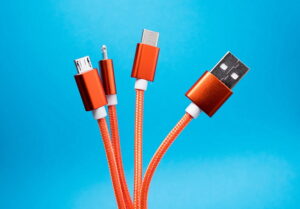
What are These Things?
OK so you got a bunch of those wires with different looking ends and you don’t know which one of these connects to the device you want to connect to. Here we will unfold that mystery for you!
USB Overview
They are called USB (Universal Serial Bus) cables. There are several types of USB connectors that have been developed over the years, but it is worth noting that USB connectors can have different versions, indicating the supported USB specification and data transfer speeds.
For example, USB 2.0, USB 3.0 (also known as USB 3.1 Gen 1), USB 3.1 (also known as USB 3.1 Gen 2), and USB 3.2 are different versions with varying capabilities.
USB (Universal Serial Bus) cables come in various types, each designed for specific purposes and compatibility with different devices.
Here’s an overview of the most common types of USB cables:

-
- USB Type-A: USB Type-A is the standard and most recognizable USB connector. It has a rectangular shape and a flat, rectangular end. These are most commonly found on computers, laptops, and game consoles. They are used to connect peripherals such as keyboards, mice, printers, external hard drives, and flash drives.
-
- USB Type-B: These connectors are larger than Type-A. They are square-shaped and have beveled corners. You would see them on laptops that connect to a printer or external hard drives.There are various subtypes of Type-B connectors. Let’s take a look.
-
-
- Standard-B: Standard-B connectors are the ones you would be most familiar with. They connect printers, scanners, and other peripheral devices. They have a square shape with two rounded corners but are less common in modern devices.
- Mini-B: Mini-B connectors are smaller than Standard-B and were commonly used with older cameras, MP3 players, and other small electronic devices. They are gradually being phased out in favor of Micro-B connectors.
- Micro-B: These connectors are smaller than both Standard-B and Mini-B connectors. They are commonly used with smartphones, tablets, portable hard drives, and other compact devices. Micro-B connectors are reversible, making them more user-friendly. There are two subtypes of Micro-B connectors: Micro-B USB 2.0 and Micro-B USB 3.0.
-
-
- USB Type-C: Type-C is a newer, versatile, and increasingly popular connector. It features a small, reversible design that allows for easy plug orientation. Type-C cables can be plugged in either way, eliminating the frustration of trying to find the correct orientation. They are used in a wide range of devices, including smartphones, tablets, laptops, desktop computers, gaming consoles, and peripherals. Type-C cables have numerous advantages over their predecessors. They support faster data transfer speeds and higher power delivery and can transmit audio and video signals through alternate modes like DisplayPort or HDMI. Type-C connectors are backward compatible with USB 2.0 and USB 3.0 standards using appropriate adapters or cables.
-
- USB Mini-A and Mini-AB: Mini-A connectors are smaller and less common than Type-A connectors. They were primarily used in older digital cameras, MP3 players, and other portable devices. USB Mini-AB connectors combine the features of both Mini-A and Mini-B connectors, allowing devices to function as either a USB On-The-Go (OTG) host or a peripheral device.
-
- USB 3.0 Type-A and Type-B: USB 3.0, also known as USB 3.1 Gen 1, introduced faster data transfer speeds compared to USB 2.0. USB 3.0 Type-A connectors are backward compatible with USB 2.0 Type-A ports, while USB 3.0 Type-B connectors provide improved speeds for compatible devices such as external hard drives.
-
- USB 3.1 Type-C: USB 3.1, also known as USB 3.1 Gen 2, further improved data transfer speeds over USB 3.0. USB 3.1 Type-C connectors offer faster speeds, higher power delivery, and support for alternate modes for audio, video, and other protocols. USB 3.1 Type-C cables are backward compatible with USB 3.0 Type-A and Type-B connectors using appropriate adapters or cables.
-
Summary
It may be confusing in the beginning, but keep in mind that the most used one is the Type-A, and then you can take it from there.
